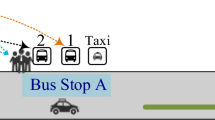Abstract
Instability is a common problem in deep belief network–back propagation forecasting model, and the trend of traffic data will affect the forecasting results of the model. Therefore, this paper proposes a short-term traffic flow forecasting method based on deep belief network–support vector regression. Support vector regression classifier SVR is used at the top of the model. Data processing is from bottom to top. Firstly, at the bottom of the model, the input traffic flow data are processed differently; then, the DBN model is used to learn the traffic flow characteristics. Finally, SVR is used to predict the traffic flow at the top of the model. The average absolute error of the prediction is 9.57%, and the average relative error is 5.91%. The relationship between the predicted value and the actual traffic flow data is found through simulation experiments. The predicted value of the model proposed in this paper is in good agreement with the measured value, and the prediction accuracy is high. The model can effectively predict short-term traffic flow. Finally, compared with the traditional DBN prediction model and other common prediction models, the proposed prediction model has higher prediction accuracy.










Similar content being viewed by others
References
Vlahogianni EI, Karlaftis MG, Golias JC (2005) Optimized and meta-optimized neural networks for short-term traffic flow prediction: a genetic approach. Transp Res C 13(3):211–234
Lv Y, Duan Y, Kang W et al (2015) Traffic flow prediction with big data: a deep learning approach. IEEE Trans Intell Transp Syst 16(2):865–873
Castro-Neto M, Jeong YS, Jeong MK et al (2009) Online-SVR for short-term traffic flow prediction under typical and atypical traffic conditions. Expert Syst Appl 36(3):6164–6173
Abadi A, Rajabioun T, Ioannou PA (2015) Traffic flow prediction for road transportation networks with limited traffic data. IEEE Trans Intell Transp Syst 16(2):653–662
Castro-Neto M, Jeong YS, Jeong MK et al (2009) Online-SVR for short-term traffic flow prediction under typical and atypical traffic conditions. Expert Syst Appl 36(3):6164–6173
Chen H, Grant-Muller S (2001) Use of sequential learning for short-term traffic flow forecasting. Transp Res C 9(5):319–336
Zheng W, Lee DH (2006) Short-term freeway traffic flow prediction: Bayesian combined neural network approach. J Transp Eng 132(2):114–121
Okutani I, Stephanedes YJ (1984) Dynamic prediction of traffic volume through Kalman filtering theory. Transp Res B 18(1):1–11
Guo H, Fang L, Yu L (2013) A short-term traffic flow forecasting method based on fuzzy Kalman filter. J Zhejiang Univ Technol 41(2):218–221
Guo J, Huang W, Williams BM (2014) Adaptive Kalman filter approach for stochastic short-term traffic flow rate prediction and uncertainty quantification. Transp Res C 43:50–64
Li D, Dong Y (2014) Deep learning: methods and applications. Now Publishers Inc, Boston
Han C, Song S, Wang CH (2004) A real-time short-term traffic flow adaptive forecasting method based on ARIMA model. Acta Simulata Syst Sin 16(7):1456–1530
Huang W, Song G, Hong H et al (2014) Deep architecture for traffic flow prediction: deep belief networks with multitask learning. IEEE Trans Intell Transp Syst 15(5):2191–2201
Huang W, Song G, Hong H et al (2014) Deep architecture for traffic flow prediction: deep belief networks with multitask learning. IEEE Trans Intell Transp Syst 15(5):2191–2201
Xue J, Shi Z (2008) Short-time traffic flow prediction based on chaos time series theory. J Transp Syst Eng Inf Technol 8(5):68–72
Xiaojian HU, Wang W, Sheng H (2010) Urban traffic flow prediction with variable cell transmission model. J Transp Syst Eng Inf Technol 10(4):73–78
Fernández-Navarro F, de la Cruz MA, Gutiérrez PA, Castaño A, Hervás-Martínez C (2018) Time series forecasting by recurrent product unit neural networks. Neural Comput Appl 29(3):779–791
Hong WC, Dong Y, Zheng F et al (2011) Hybrid evolutionary algorithms in a SVR traffic flow forecasting model. Appl Math Comput 217(15):6733–6747
Ai Y, Li Z, Gan M, Zhang Y, Yu D, Chen W, Ju Y (2019) A deep learning approach on short-term spatiotemporal distribution forecasting of dockless bike-sharing system. Neural Comput Appl 31(5):1665–1677
Zhang HZ, Wang J (2008) Application of data mining on short-term traffic flow forecasting model. Comput Integr Manuf Syst 14(4):690–695
Xu JR, Li XY, Shi HJ (2010) Short-term traffic flow forecasting model under missing data. J Comput Appl 30(4):1117–1120
O’Connor P, Neil D, Liu SC et al (2013) Real-time classification and sensor fusion with a spiking deep belief network. Front Neurosci 7(7):178
Kuremoto T, Kimura S, Kobayashi K et al (2014) Time series forecasting using a deep belief network with restricted Boltzmann machines. Neurocomputing 137(15):47–56
Kang S, Qian X, Meng H (2013) Multi-distribution deep belief network for speech synthesis. In: IEEE international conference on acoustics, speech and signal processing. IEEE, pp 8012–8016
Shi X, Zhu Y, Sa C et al (2016) Power transformer fault classifying model based on deep belief network. Power Syst Prot Control 44(1):71–76
Ji NN, Zhang JS, Zhang CX (2014) A sparse-response deep belief network based on rate distortion theory. Pattern Recogn 47(9):3179–3191
Fernandez R, Rendel A, Ramabhadran B et al (2013) F0 contour prediction with a deep belief network-Gaussian process hybrid model. In: IEEE international conference on acoustics, speech and signal processing. IEEE, pp 6885–6889
Liu T (2010) A novel text classification approach based on deep belief network. Neural information processing. Theory and algorithms. Springer, Berlin, pp 314–321
Author information
Authors and Affiliations
Corresponding author
Ethics declarations
Conflict of interests
There are no conflicts of interests of this work.
Additional information
Publisher's Note
Springer Nature remains neutral with regard to jurisdictional claims in published maps and institutional affiliations.
Rights and permissions
About this article
Cite this article
Xu, H., Jiang, C. Deep belief network-based support vector regression method for traffic flow forecasting. Neural Comput & Applic 32, 2027–2036 (2020). https://doi.org/10.1007/s00521-019-04339-x
Received:
Accepted:
Published:
Issue Date:
DOI: https://doi.org/10.1007/s00521-019-04339-x




